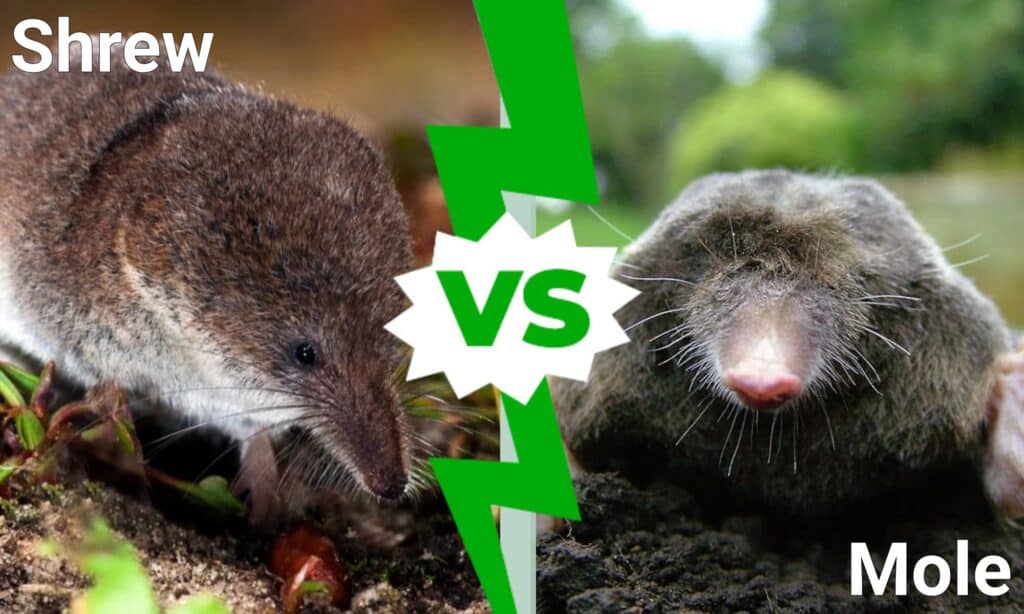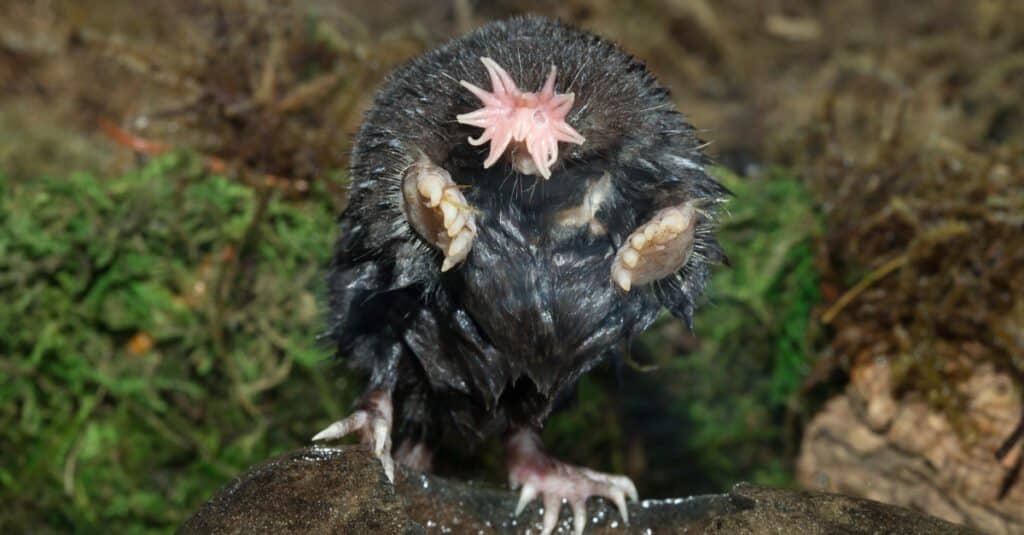While these two tiny rodents may look similar upon first glance, there are many differences between a shrew vs mole. But what might some of these differences be, especially if you aren’t sure which animal is which in the first place? Both of these rodents have many fascinating features and traits, individual to them!
In this article, we will discuss all of these individual features, including what shrews and moles prefer in their habitat and diet. We will also discuss the physical differences between these two animals so that you can tell them apart at first glance. Let’s get started and learn about shrews and moles now!
Comparing Shrew vs Mole

| Shrew | Mole | |
| Size | 1-6 inches long; 1-4 ounces | 4-8 inches long; 8-20 ounces |
| Appearance | Extremely small; found in gray, red, black, or brown colors. Large ears and narrow skulls with pointed nose. Very small eyes. | Huge hands with sharp claws for digging; eyes are not usually visible. Short, pointed snout and rounded body; covered in dark brown or black fur that is extremely soft. |
| Location and Habitat | Found worldwide in temperate climates; prefers woodlands and grasslands | Found worldwide in temperate climates; prefers loose and moist soil for digging |
| Behavior | Spends time above ground hunting for food, but may steal the burrows of other animals for protection | Rarely comes to the surface, living their entire life underground. Digs tunnels prolifically and leads a solitary life |
| Diet | Omnivore; insects, invertebrates, small aquatic animals | Omnivore; insects, mice, earthworms |
Key Differences Between Shrew vs Mole

Shrews come in a wide variety of colors compared to moles, and shrews do not have the powerful clawed feet that moles have.
©Nadine Klose/Shutterstock.com
There are many key differences between a shrew vs mole. Moles are much larger than shrews on average, in both length and weight. Shrews come in a wide variety of colors compared to moles, and shrews do not have the powerful clawed feet that moles have. Moles spend the majority of their life underground, while shrews enjoy hunting on the surface.
Let’s discuss some of these differences in more detail now.
Shrew vs Mole: Size and Weight

Moles spend the majority of their life underground, while shrews enjoy hunting on the surface.
©pictoplay/Shutterstock.com
One of the main differences between shrews and moles is their size and weight differences. Shrews are extremely small individuals, often growing only 1-6 inches long, while moles reach 4-8 inches long. The average weight of a mole is 8-20 ounces, while shrews weigh 1-4 ounces on average, which means that moles are much larger overall.
While there are many different species of both shrews and moles, the average mole will most likely always be bigger than the average shrew. Seeing a shrew longer than six inches and weighing more than 4 ounces is extremely rare, as these rodents are very tiny!
Shrew vs Mole: Location and Habitat Preferences

Shrews do not seek out soil like moles do, given that they only live underground for protective purposes.
©Rudmer Zwerver/Shutterstock.com
While both shrews and moles are found worldwide in a variety of different habitats, they do have different preferences in terms of their living quarters. For example, shrews enjoy spending their time above ground in grassy regions and forests, while moles spend their entire lives underground. But what might a mole prefer, given that they live in soil?
Moles seek out habitats with loose and moist soil, which makes it easier for them to dig their complicated tunnels. Shrews do not seek out soil like moles do, given that they only live underground for protective purposes. Depending on the location, both shrews and moles develop unique characteristics to match their location.
Shrew vs Mole: Appearance

The skull of a shrew differs from that of a mole in that it is extremely long and narrow, while a mole’s skull is short and small.
©Bildagentur Zoonar GmbH/Shutterstock.com
Despite both of these creatures being small, you can easily tell the difference between a shrew and a mole when you put them side-by-side. Moles have powerful arms and feet, complete with sharp claws that they used to dig, while you may not even notice what a shrew’s feet look like. Let’s discuss more of their physical differences now.
Shrews come in more colors than moles do, such as gray, red, black, and white. Moles maintain an extremely soft and dark colored coat which they use to navigate their tunnels. The skull of a shrew differs from that of a mole in that it is extremely long and narrow, while a mole’s skull is short and small. The nose of a shrew is pointed and long, while mole noses are smaller overall.
Both of these creatures don’t have very distinctive eyes, but you can see a shrew’s eyes sometimes, while mole eyes are rarely visible. However, you should be able to see a shrew’s ears, but moles do not have ears visible on their body.
Shrew vs Mole: Behavior

Both of these creatures don’t have very distinctive eyes, but you can see a shrew’s eyes sometimes, while mole eyes are rarely visible.
©iStock.com/CreativeNature_nl
There are some key behavioral differences between a shrew and mole. Given that moles spend their life underground, they spend significantly more time in tunnels and burrows compared to shrews. The average shrew needs to hunt throughout the day in order to support its fast metabolism, so they are often found on the surface, a trait in exact opposition to moles.
Both shrews and moles are solitary and extremely territorial creatures, though moles are capable of digging their own tunnels, while shrews tend to take any borrow that suits them. Moles are adapted to living underground in every way, while shrews only do it out of necessity.
Shrew vs Mole: Diet

Both shrews and moles are solitary and extremely territorial creatures, though moles are capable of digging their own tunnels, while shrews tend to take any borrow that suits them.
©Agnieszka Bacal/Shutterstock.com
A final difference between shrews and moles is their dietary preferences. Both of these small creatures are omnivores, and they enjoy eating insects. However, moles eat earthworms primarily, while shrews eat aquatic and land dwelling creatures as part of their diet.
The photo featured at the top of this post is © Rudmer Zwerver/Shutterstock.com
Thank you for reading! Have some feedback for us? Contact the AZ Animals editorial team.






